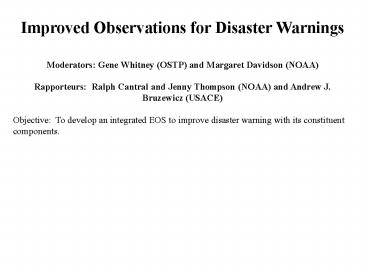Improved Observations for Disaster Warnings - PowerPoint PPT Presentation
1 / 6
Title:
Improved Observations for Disaster Warnings
Description:
( Aside from reduction in the loss of life and property damage. ... Aspects include spatial and temporal, disciplinary, land, water, and air ... – PowerPoint PPT presentation
Number of Views:36
Avg rating:3.0/5.0
Title: Improved Observations for Disaster Warnings
1
Improved Observations for Disaster
Warnings Moderators Gene Whitney (OSTP) and
Margaret Davidson (NOAA) Rapporteurs Ralph
Cantral and Jenny Thompson (NOAA) and Andrew J.
Bruzewicz (USACE) Objective To develop an
integrated EOS to improve disaster warning with
its constituent components.
2
- What makes observations for improved disaster
warnings a near term opportunity? What makes
disaster or hazards observations a near term
opportunity? - Technology is now ripe
- Lots of data
- Indian Ocean Tsunami
- Political will in the US
- Disasters can be worked even in the face of
political differences - What will be the benefits of an integrated
observation system for disaster warnings? (Aside
from reduction in the loss of life and property
damage.) - Fewer false alarms and evacuations
- Mitigation of cascading disasters
- Ability to pass common data over common
communication channels
3
- What should be the scope of an integrated
observation system to improve disaster warnings? - Open access with certification by governmental
bodies - Need to compartmentalize responsibilities
without creating orphan requirements - Interagency support
- Integration is not centralization. Aspects
include spatial and temporal, disciplinary, land,
water, and air - Disaster data collection and observation exists
in a larger context including planning, analysis,
and product delivery - What are the major scientific and technological
challenges (and barriers)? - Building connections between systems
- Effective and verified predictive models
- Understanding of the underlying physical
processes - More robust instruments with high resolution or
density - Design and updating of GIS products
- Inclusion of social scientists
- Awareness of uncertainty issues, accuracy, and
precision of the data.
4
- N Year Integration Framework
- Supplement critical databases using existing
technology (especially topography and shallow
bathymetry) (2 year) - Improve resolution with new instruments (6 and
10 years) - Capture current benefits of through a
multihazard approach - Deformation measurement and other benefits from
SAR. Existing instruments (2 year) and new
capabilities (L band) - Develop a prototype integrated system.
Inventory, assess and address know deficiencies
in system components (sensors, data, models, DSS
tools), identify deficiencies, improve critical
components, develop model and DSS metadata. (2-6
years) - Sea bed seismology (6-10 years)
- Next generation thermal sensors (6-10 years)
including evaluation of existing systems (2
years) - Data archive and retrieval systems
- Soil moisture forecasting
- Evaluate use of UVs and UAVs
5
(No Transcript)
6
(No Transcript)































